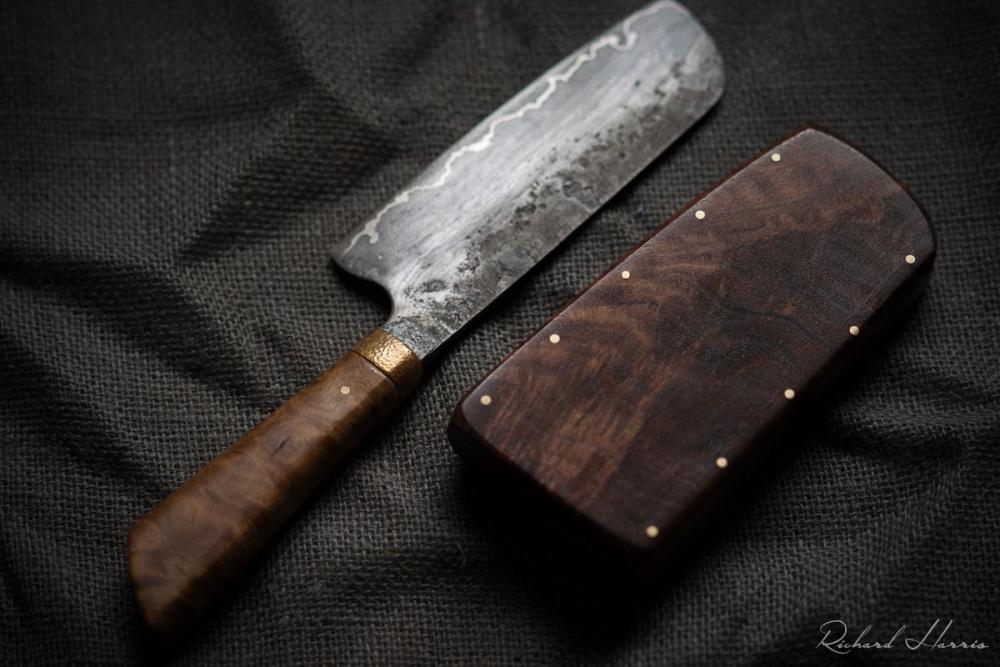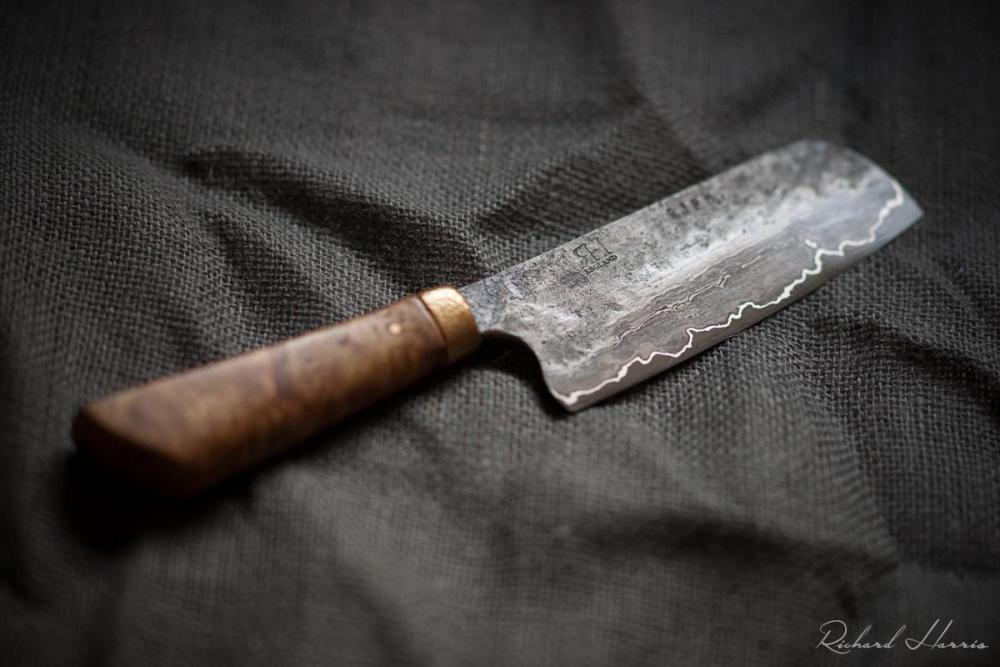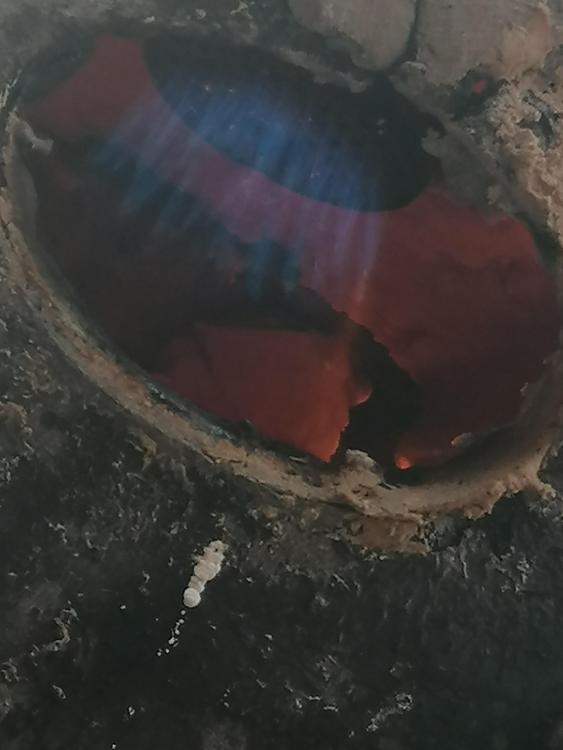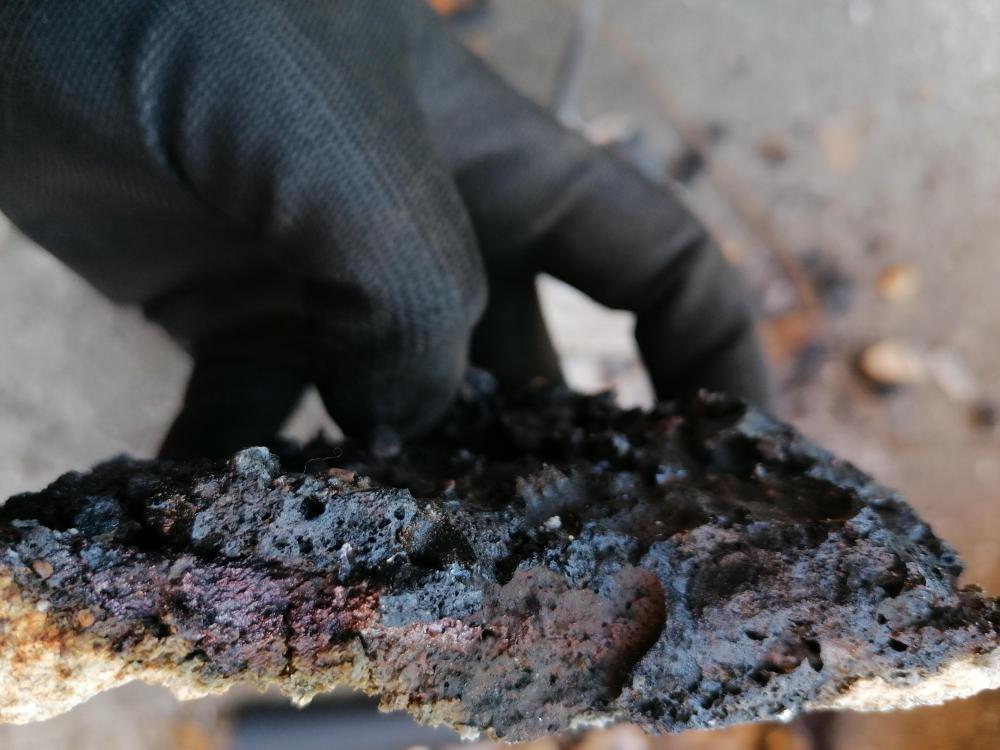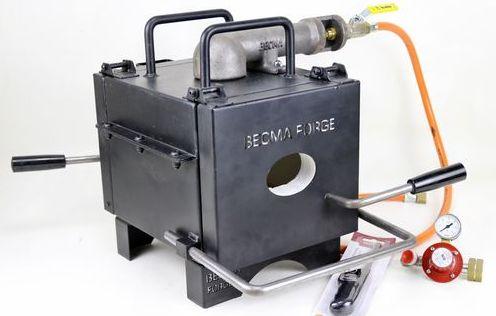
RHarris
Members-
Posts
12 -
Joined
-
Last visited
Profile Information
-
Gender
Male
-
Location
England, UK
-
Interests
Hot stuff
Recent Profile Visitors
The recent visitors block is disabled and is not being shown to other users.
-
Induction Forge - Will it melt ?
RHarris replied to symeou's topic in Induction Heating, Oil forges, etc
Sorry to jump in here, but do you have any idea how much iron a 15kw induction forge could melt, in small batches? And I'm right in thinking it is capable of actually melting the steel in a crucible? -
Okay, new symptom.... I can't run the forge at a lower temp. When I dial it down, it just cuts out and starts spluttering from the jet itself rather than the burner. If that makes sense? I can try and get a video of this if possible. It also cut out at what I'd say a 'moderate' temperature / rate of fuel a couple of times. I have no gauge on the regulator, so have no numbers to quote I'm afraid... Not a massive issue immediately but far from ideal. Uses more fuel and risk of over heating some parts. Also makes normalising cycles from the forge almost impossible as its just too hot (I do proper kiln cycles but like to reduce the grain from welding heats using the forge as well) What do you all think? Need to seek a new jet?
-
Thomas, looks like an absolute beauty! I have seen many in the USA use this type of screw press with the cylindrical top... You call it a screw press instead? Fly press on apply to those with the balls on top? I wonder if you added balls / more mass it would pack an even bigger punch? My fly press is pretty sad. I'll see if I have a photo. Got it as it was the cheapest and nearest I could find! Was about £45 I think. BUT one of the arms had been cut off. Cut off! It's friggin wrought iron as well. What an unforgivable act! So it's got my bodged flux core welded arm on it and a giant old hammer head, if similar weight, attached as an extra ball weight. Then I spend about £100 just on materials to make the stand... I mean it's made its worth back several times over. But now that I've used one, I'd 100% just spend considerably more to get a much larger one in good working order and with a stand. I've got some aggressive drawing dies on mine which can move a surprising amount along without 'power'. Particularly helpful if you're stretching something 10-12" long or your billet is an inch thick, both of which apply to me. Yeah these things can be frustrating can't they. But the mod did explain why and what happened, so I have no hard feelings.
-
Thomas, if yours is similar to that, it looks an absolute beauty! I love the simplicity of the fly press. They can be really effective tools. I think I'd want as big as possible just for more mass, more energy. Wouldn't be interested in motor powered that would take away the beauty of it for me. But yeah, I'll see how my body copes! Frosty, yeah, I've been given a lifetime fine apparently. I did write to the moderator and apologize. It's a cultural difference. The word I used isn't considered offensive or inappropriate at all in the UK. My mistake of course, I shall think twice next time. Not a very good start for me though is it? Yeah it's san mai. I used to do mono steel constructions and still do, but san mai makes many things easier and is a more poetic process. Frazer, yeah I've read that as well. Part of the reason I use it. However I don't have the tools to test the difference / effectiveness of this (I only have basic HTC files). My only observation is in earlier testing, without the nickel, I definitely wasn't reaching max hardness out the quench. BUT, I also discovered I was using the wrong quench oil (too fast). But when I changed that, I also started using the nickel, so no scientific process to understand what was at play. As mentioned I am not using any power tool to move the hot metal, so I figure reducing carbon migration can only be helpful.
-
Thanks. Yeah nickel between the wrought and steel. It's a bit bold at times, sometimes I prefer just the wrought, but it does catch the eye.
-
Xxxx, I shall go through and remove the "at" signs, sorry about that. This is one from 2 years ago, a 30th birthday gift for my brother in law. I made it from wrought iron from by his parents place (where he grew up). I've changed my etching process since this but I am still pleased with it, had great balance and tackled dense starchy veg easily as well. It was quite tricky getting it to him, as he lives in Belgium.... this coincided with the UK leaving the EU more formally and the pandemic... but it got there eventually. I have a life long love of cooking so kitchen knives are a natural choice for me. However, when we are able to move and I can build my own workshop, I would like to explore other areas much further. I am using a large antique wrought iron with steel face anvil (not really sure of make of weight, no markings, I've looked very thoroughly). I'm also using a relatively small fly press, which I love. When we move, I am debating whether to move to a hydraulic press or the biggest fly press man can make. Happy forging everyone!
-
@Frosty thanks for your thoughts! Alas I have used the ptfe tape on the brass parts as I wasn't even aware of this paste stuff. I was very careful with cutting off any excess so I'm reasonably confident it's all clean in there. I think I may have mistyped what I said before - I was actually surprised that the slag/flux hadn't appeared to eat into the floor at all really. I'm not entirely sure what the high temp cement stuff was I used most recently but it certainly seems to be doing the job! Insulating but also appearing to not being eaten by the high temp or flux. Indeed I also found like most that the cheap fire bricks dissolve like ice cubes. Trouble is I bought a whole box of them years ago so I sort of use them here and there to patch, just because I have them! Perhaps if I keep this forge going longer than I once thought, I can look more into what types of refractory I can get over here and do a better job at it all. I don't have a carbon monoxide detecter but my setup is that the forge and tank are actually outside a doorway. Minor faff to setup but the doorway isn't used for anything other than this forge so I store the forge right in the doorway, it's pretty easy to setup. For that reason I presume all the carbon monoxide is just being released outside and isn't building up anywhere? Worth noting I also forge in a good mask. @Steve Sells I was attempting to weld it in an oxygen free environment, so not flux needed. However when I attempted that, I Was also experiencing none welding heat, so I stood no chance at welding it together! @Mikey I will have to checkout this paste stuff then for the future! Sorry I agree the photo is turd. I found it difficult getting the photo without setting my phone on fire. The burner is a shower head type, is that responsible for the unusual flame shape? Or is it cursed? UPDATE So my attempt at replacing the hose setup failed. The tap has a 1/2 RHT BSP and the hose is a 3/8 BSP LHT. It seems getting a 1/2 RHT to 3/8 LHT reducer is rather difficult. But anyway, I have half a new hose fitted to it and a new regulator. Leak checked everything and fixed a couple of minor leaks. Turned it on low and let it burn slowly for 30mins or so. At this point I could already see it was working better. Ramped it up and it got to welding temp easily. In fact it was even getting a bit out of control. I was getting white hot very quickly and had to dial it down. So I'm pleased it is working normally again! I guess the issue is I don't actually know what the problem was. Perhaps the regulator? Or the jet? The jet never seemed to be obstructed to have need cleaning when I took it apart but who knows. Anyway, much appreciate you all sharing your thoughts. I at least understand it much better now and should I encounter the problem again in the future, I feel like I'll be able to problem solve more effectively! Happy forging!
-
Don't know how helpful this is but this is like a minute after I've lit it up. Do you the fuel air mix is behaving? I am just letting it run on low for a bit at the moment, will try cranking it up soon to see if it can reach the high temps.
-
Again trying to rule out possible issues, I've inspected the lining. Now I did some patch work on this in Oct and Jan, so I didn't suspect any issues. What I found was almost an inch of caked slag on the base of the forge. I assume from wrought iron and borax. But it was sat on top of the lining, had nearly eaten into anything at all... Not sure how... Perhaps the latest refractory cement I used is more agreeable. Anyway going to sort the base of the forge out before I start it up again of course. I should add what I'm calling the base is actually a layer I've built up with additional bricks and refractory cement, I'm nowhere near the original base which is some 1 1/4 thick I think.
-
Just a short side note here - I cannot recommend the Becma forges. I think they're really well made (in my limited experience), but the customer service is dreadful. When I ordered it, I think I had a 2-3 month wait until dispatch with no communication unless I hunted them down. I've contacted a few times over the years for things and they just try to sell you something without listening to the issue at all. The response I got back this morning was that my forge is not suitable for forge welding. If I over heat the insulation, it could be destroyed. If this is the case, I must replace the insulation. Good grief!!! I'd just told them I'd relined the forge regularly, forge weld in it regularly. It was actually rated as being a weldable one when purchased as well. Madness. When I bought it, there were very few options in the UK, so I had this one imported from Germany. We were still in the EU then. I doubt anyone would import this now we've left the EU. There are also much more affordable options out there now that I'm sure will do the same job. But for anyone in Europe who may be considering one, just a "heads up". Frosty yeah I don't think I really fancy trying to clean out a hose that will probably cost me about £10 to replace, with the potential for explosions :). How often do you replace your hoses? Just if you see any leaks? I have read you should replace them every 5 years, but perhaps that is just a residential law. There really wasn't much waxy stuff at all, I just noticed small amounts around the fittings. And interestingly none in the jet... I've given the jet hole a clean out anyway, as best I can. Leather Bill I mentioned this waxy greasy issue to a fellow forger who's got decades of experience with propane, he's also never experienced it. So perhaps it is luck of the draw with what propane you get... Mikey In the UK there are two propane suppliers, calor and flogas. They're very similar in price. I don't feel like one known as an inferior or cheap product, so perhaps I have just been unlucky somehow. That's real interesting that you've actually seen the crud at the bottom of the tanks yourself though. This current tank I'm on was from when there was a gas crisis a few months back in the UK. Shortages. Perhaps they were scraping the bottom of the barrel, literally!
-
Billy, Thomas, Frosty, Mikey and IronDragon - that you all very much, I sincerely appreciate your help (and welcoming!). Firstly, I apologise for the posting the link and thank you to the moderator for fixing that. I admit I signed up a year or two ago, read all the rules but then yesterday posted in more of a mad panic than anything else! This is really interesting and I had absolutely no idea propane could produce this waxy greasy impurity over time. New knowledge to me. As reading what you describe @Frosty, it occured to me that when I was taking the hoses apart yesterday I did notice one of the fittings seemed a tady greasy. I didn't think much of it. Now that I've taken things apart further and inspected, I can see greasy waxy stuff over most of the fittings. Not loads, but there is some there. I've specitically taken apart the jet/nipple bit. The outside is a bit covered in carbon but that specific part doesn't appear to be obstructed (unfortunately?), I almost wish it was then the answer would be clearer. I have ordered a new hose and regulator that will appear in 2 days time. I figure if the hose is such is waxy, there could be some in the regulator as well. As you describe re the "dark spot" is pretty much exactly as I see it as well Frosty. I had a family event today so didn't have time to get it up and running/take photos, but I'll do this when the parts arrive, as per the suggestions of what would be handy to see. I'm not replacing the on/off tap, as I see no issue with that. The jet part, I also see no issues with it yet, but have found a similar item I could replace it with if needed. Thank you again for the help. Hopefully it'll get back to normal soon!
-
Hey, so I am firstly I apologise for the slightly panicked introduction. I've read this forum a few times over the years and it has some really great content! I would contribute more if I had any knowledge worth sharing ;-)! Alas I am in a sticky situation. I have a single burner gas forge from Becma in Germany. Very similar to this one, only mine must be a slightly earlier version (as it's a few years old). Only different I can see is the doors are a bit thicker on this new one: I have been running it on a hobby then part time basis, so not extensively. You can definitely forge weld in this forge. I have done so many times with both mild steel and wrought iron. I ran it a few weeks ago and felt a bit bummed my stainless san mai experiment didn't go so well, but also felt like something wasn't running right. This afternoon I prepped two billets perfectly of mild + high carbon san mai. Followed my normal procedure. It is definitely not reaching temperature. This was in bright daylight (the forge, not anvil), so not ideal for gauging but I'd say I Was getting an orange colour at best and not evenly, definitely not to the temperature I weld at. Any ideas where to trouble shoot with this? I've not experienced this before. Some observations: - It seemed to actually sound a little different - There almost appeared to be a black spot in the center of the forge, on the floor. no idea if that's just some slag or material I've forgotten about, or what. - My tank is probably 75% full (and is a big 47kg tank, there is definitely sufficient gas) - I've maintained the walls, floor and doors with high temperature materials - The hose seems fine, no leaks. - The regulator also appears fine but I'm not sure how I'd test that, nor how I'd know if it were at fault - I am pre heating the forge at a medium rate for about 15 mins then blasting it up high. Just doesn't seem to get there. It's never a great timing when these things happen, is it? I have been forging on a part time basis since the pandemic, as my day job stopped completely. There has also been considerable life trauma the past couple of years (as I'm sure many can relate), so for now this is my only income. I find it very peaceful and good for my soul. I think anyone who works with their hands will get that. We were hoping to move in the next 18 months, which would involve moving the workshop. At which point I was hoping to transition to induction only. However, perhaps I may need to get a small replacement gas forge if I can't get this one going :/ Sorry for the ramble and if you have the time and any thoughts to spare, it would be sincerely appreciated. -Richard
